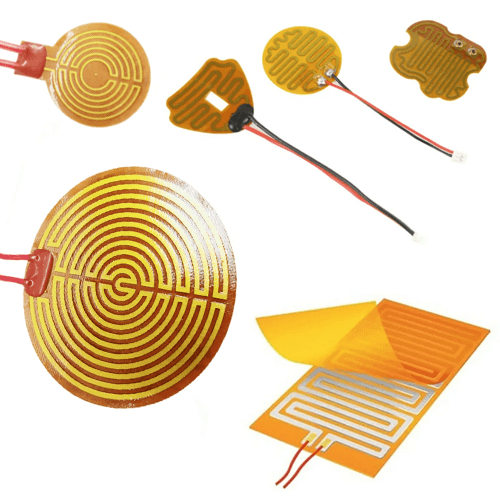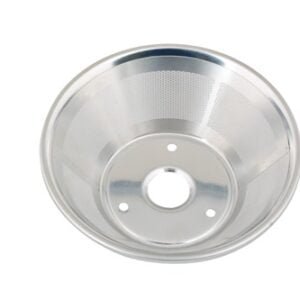Our custom Thin Film Heating Elements are designed to provide high-performance, space-saving, and energy-efficient heating solutions. Made from flexible materials like Polyimide (PI) and PET, these heaters offer superior temperature control and heat distribution across various applications. Whether you need to heat a small, intricate part or a larger surface, our thin film heating elements can be customized to meet your specific requirements. Below are some of the key features and real-world applications:
Film heating elements Features:
- Compact and Lightweight: Thin heating elements that save space and reduce overall operational costs by providing localized heating where it’s needed.
- Fast and Efficient Heat Transfer: Ensures quick, uniform heating with high thermal efficiency.
- Low-Profile Design: The structure and factory-laminated layers save space and reduce cycle time.
- Customizable Shapes: Available in round, rectangular, and irregular shapes to suit various designs.
- Chemical Resistance: Highly durable and resistant to most chemicals.
- Turnkey Assembly Options: Custom designs allow for ready-to-install solutions.
- High-Temperature Capabilities: Maximum working temperature up to 260°C (custom options available to meet your needs).
Case Application & Description
| 1. Battery Silicone Heating Pads In cold environments, preheating the battery ensures optimal power delivery. Flame-retardant silicone heating pads provide a reliable heat source for lithium battery packs, improving heat efficiency and extending product lifespan. | |
 | 2. Camera Lens Heating Pads Round PI heating films prevent fogging on camera lenses, ensuring clear images in harsh conditions. Customizable thickness (0.15-0.4mm) with easy-to-install 3M adhesive backing. |
| 3. Wiper Blade PI Heating Pads PI heating elements quickly clear moisture from wiper blades, enhancing their performance in wet conditions. Compact, energy-efficient, and easy to install. |  |
 | 4. CPAP Machine PI Heating Pads PI heating elements, integrated with aluminum plates, provide comfortable air temperatures for breathing devices. Built-in temperature sensors and fuses ensure safety. |
| 5. IV Tube Heating Pads PI heating pads are used in medical IV tube applications, designed for quick, efficient heating. They are adaptable, easy to install, and highly durable. |  |
 | 6. Beauty Device PI Heating Pads PI heating films are perfect for beauty devices, offering flexibility to contour to flat or curved surfaces, ensuring uniform heating for effective treatments. |
| 7. Bottle Warmers & Heating Cups Thick film heating elements ensure consistent heating in bottle warmers and cup heaters, offering energy efficiency for consumer products like baby bottle warmers and heated drink containers. |  |
 | 8. Robot Vacuums and Floor Washers Thick film heating plates in cleaning robots and floor washers provide reliable heating, enhancing cleaning performance. Ideal for use in home appliances. |
| 9. PET Heating Pads PET heating pads are semi-transparent, safe, and easy to install with customizable shapes, voltage, and power specifications. Ideal for applications requiring lower operating temperatures (~90°C). |  |
 | 10. Low Voltage PET Heating Pads Low-voltage PET heating pads are flexible and safe for use in close-to-skin applications, providing reliable, fire-free heating. Perfect for low-voltage heating devices. |
| 11. Screen Heating Pads PET polyester heating pads are semi-transparent with 3M adhesive backing, making them easy to install on screens or displays, compatible with both AC and DC voltages. |  |
 | 12. Ceramic Mug Heating Pads PET ceramic heating films are placed at the bottom of mugs for efficient heat retention. Easy to mount with adhesive or mechanical methods, offering energy savings. |
| 13. Beauty Instrument Heating Films PI heating films provide consistent warmth in beauty instruments. They are lightweight, flexible, and highly effective for skincare and treatment equipment. |  |
Our custom thin film heating elements are tailored to meet the unique needs of each application, providing energy-efficient, space-saving, and high-performance solutions for a wide range of industries. Let us help you design a heating solution that fits your exact specifications!
Combinations of Materials in Thin Film Heating Elements
In Thin Film Heating Elements, the materials used for both the heating layer and the substrate can significantly impact the performance, flexibility, and durability of the final product. The most common material combinations include Polyimide (PI) + metal and Polyethylene Terephthalate (PET) + metal, though there are other material pairings that can be tailored for specific applications.
Common Material Combinations:
PI + Metal (Aluminum, Stainless Steel, Copper):
- Polyimide (PI) is a high-performance polymer known for its excellent thermal stability, electrical insulation, and flexibility. When combined with metals such as aluminum, stainless steel, or copper, PI provides a flexible and durable platform for high-temperature and high-power heating applications. These combinations are often used in industries such as aerospace, automotive, and medical devices, where both high thermal conductivity and high resistance to heat are essential.
- Aluminum is commonly used for its lightweight properties and good thermal conductivity, while copper provides superior thermal efficiency. Stainless steel offers higher durability, making it suitable for harsher environments.
PET + Metal (Aluminum, Stainless Steel, Copper):
- PET (Polyethylene Terephthalate) is a more cost-effective material compared to PI but still offers good flexibility, thermal stability, and strength. When paired with metals like aluminum, stainless steel, or copper, PET is often used for low to medium-temperature applications.
- This combination is ideal for products that require moderate heat resistance, such as consumer electronics, low-voltage heaters, and small appliances. Aluminum and copper provide excellent heat conductivity, while stainless steel is typically chosen for applications that demand enhanced corrosion resistance.
Other Material Combinations:
- Ceramic + Metal: Ceramic materials can also be used for high-temperature heating elements, especially when paired with metals like stainless steel. This combination is often used in applications requiring extremely high heat resistance, such as industrial ovens and heating plates.
- Silicone + Metal: Silicone rubber combined with metals is commonly used in flexible, high-power heating elements, particularly in automotive or battery heating applications.
Processing Methods for Film Heating Elements
When it comes to manufacturing metal heating pads, the patterning and shaping of the metal layer are crucial for ensuring efficient heat distribution and performance. The most common method for processing thin metal layers used in Thin Film Heating Elements is chemical etching.
Metal Patterning and Etching Process:
Chemical Etching:
Chemical etching is the most widely used method for processing thin metals in heating pads, especially for aluminum, stainless steel, and copper. This process involves coating the metal surface with a photoresist material, exposing it to ultraviolet light, and then chemically etching the unwanted metal areas using an etching solution. This allows for the creation of intricate patterns and precise geometries that optimize heat distribution across the heating element.- Advantages of Chemical Etching:
- High precision and repeatability in patterning.
- Ability to create very fine details and complex geometries.
- Ability to process a variety of metals with high accuracy.
- It is a cost-effective method, especially for thin metals.
- Advantages of Chemical Etching:
Laser Cutting (Alternative to Etching):
Laser cutting can also be used for patterning metals, particularly for thicker metals or when intricate cuts are required. While more expensive than chemical etching, it offers greater flexibility in terms of material thickness and shape complexity.Other Processes:
- Mechanical Stamping: A process where the metal is shaped using a die to cut patterns. This is less common for Thin Film Heating Elements but may be used in applications requiring larger-scale manufacturing or less intricate designs.
- Photochemical Machining: Similar to chemical etching, this process uses light-sensitive chemicals to create patterns on metals, often used for more complex or precise designs.




